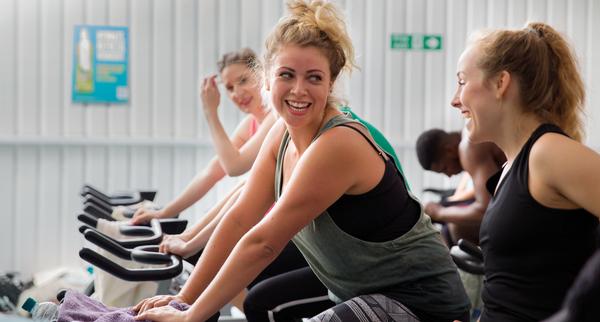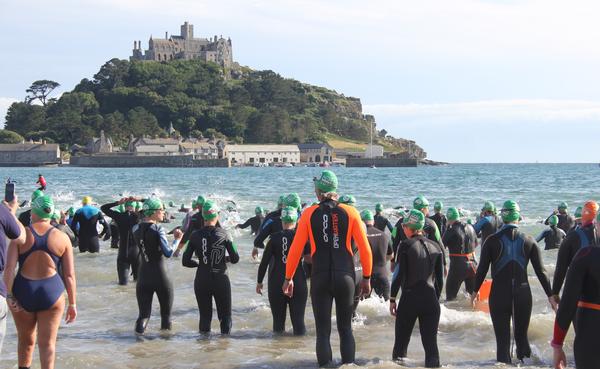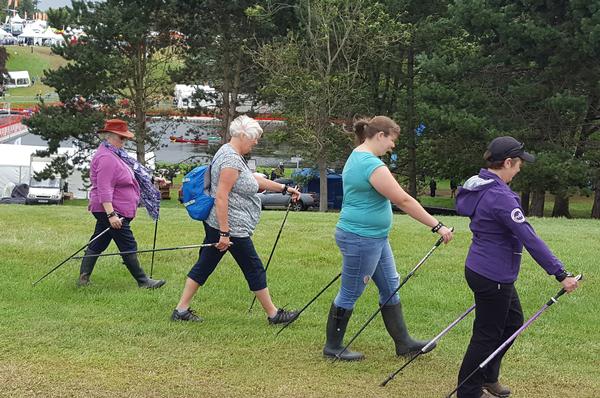 SELECTED
ISSUE
SELECTED
ISSUE
|
|
Leisure Management - First step to fitness

Round-up

|
|
| First step to fitness
|

As the deconditioned market swells, Kath Hudson explores the tools operators can use to increase the fitness levels of sedentary people who may not feel ready for the gym environment
|


While gyms can be a tough sell to the inactive, other activities could be used to attract them Photo: Thisgirlcan/sportengland
|
|
|
The 2017 State of the UK Fitness Industry Report provided some great news for the sector, with health club membership penetration rates up to an all time high of 14.9 per cent. Although this is fantastic news for our industry, unfortunately at the other end of the spectrum there are some more depressing findings, with almost half the middle aged people in the UK failing to walk continuously, at a brisk pace, for even as little as 10 minutes a month. According to Public Health England (PHE), 41 per cent of the UK’s 40 to 60 year olds – 6.3 million people – fall into this category. For these people, the recommended 150 minutes of moderate exercise a week is insurmountably high and they’ve given up. In response, PHE has launched a new app, Active 10, to encourage at least 10 minutes of brisk walking a day. Although this still falls short of the minimum guidelines, PHE is hoping that this will feel achievable and therefore help with changing behaviours. Clinical advisor for the Active 10 app, Sir Muir Gray, says that even 10 minutes of walking at a brisk pace every day reduces the risk of early death by 15 per cent. If 10 per cent of this group started walking for 10 minutes a day, then 251 premature deaths could be prevented and the NHS could save up to £310m a year. Getting these people into health clubs is a tough sell, but are there other ways the industry could reach out to engage with the deconditioned market, to start changing behaviours and possibly turn them into gym goers further down the line? We look at some activities suitable for getting the deconditioned back on track...
|
|
 |

Justin Rogers
Creative Director
Ten Pilates
 |
|
Pilates is a great activity for the deconditioned market, as the instructors are used to dealing with people with limitations. It’s non-judgmental: no one is watching as they're too busy focusing on their own practice, and everyone in the class is usually of a similar standard. For the sedentary or deskbound, it’s an excellent workout because of the focus on posture and musculoskeletal realignment.
Pilates also builds muscle stability and control, which is important for people who are deconditioned.
They may often have residual based muscle strength, but if they only work the global muscles and neglect the stabilising muscles, they can cause further imbalance and increase injury risk.
One of the problems with getting deconditioned people to the gym is that it requires so much motivation – first to get themselves there and second, to get through what is often an unsupervised, DIY workout. With a class such as Pilates, people only have to get to the class and the instructor will take care of the rest: designing the programme, ensuring proper technique and managing their progression, so it is much easier for them to stay motivated.
Ten Health and Fitness has had many successes with deconditioned people, including an obese, deskbound 40-year-old who hadn’t exercised for 20 years. She quickly saw progress, boosting her personal morale and helping her stay motivated. Eighteen months on, she has lost weight, has progressed to attending intermediate-level classes, can now manage other exercise and her 2018 goal is to run a marathon.
"One of the problems with getting deconditioned people to the gym is that it requires so much motivation. With a class such as Pilates, people only have to get to the class and the instructor will take care of the rest"
| |


|

Pilates offers a great workout for the sedentary |
|
|
 |

Salim Ahmed
Founder
SwimLab
 |
|
Swimming is a great starting point if you’re deconditioned: it’s low impact, it can be done at a pace akin to walking, and it can be built up slowly. Literally anyone can learn to swim. Age, size and culture can all be seen as barriers, but they don’t need to be. I’ve taught many elderly people, including a 65-year-old Sikh lady. In her case, every aspect of swimming took her outside of her comfort zone: from being in a swimming costume, to having a male coach and putting her face in the water, but she overcame all of them to learn how to front crawl.
There’s a huge potential market for swimming, but some issues need to be addressed. Although offering swimming lessons and technique sessions are the obvious starting point, for the deconditioned market you need to rewind, and focus first on building enjoyment of the water. To start with, it’s just about floating and being comfortable in the water, then you can look at moving with grace. I like to promote the spirituality of water: we started out living in water in the womb, our bodies are made from it and it’s the giver of life.
Some people will feel self conscious getting to and from the pool, so anything that can mitigate this will help – screening the pool so other centre users can’t spectate, ensuring swim instructors are well trained and, although I don’t usually advocate single sex sessions, these may help some people to feel more comfortable. The pool environment needs to be made as welcoming as possible, with natural light or clever lighting, maybe some music and must be scrupulously clean.
"For the deconditioned market you need to first focus on building enjoyment of the water, then move to swimming lessons"
| |


|

Virtually everyone can learn to swim at any age |
|
|
 |

Thomas Ott
Head of operations EMS UK Ltd
miha bodytec
 |
|
Electro Muscle Stimulation (EMS) training, or whole body EMS, can be used to overcome the 'lack of time' barrier that often prevents those who are unfit or simply dislike exercise from making gym sessions a regular part of their weekly schedule. As EMS is a time efficient workout, one 20-minute session is sufficient for the week – in terms of improving fitness. Once people start to lose weight, gain muscle tone and feel better, they often become more inclined to increase their activity and adopt healthier behaviours.
Carried out under the supervision of a specialist EMS personal trainer, the workout is based on electronic stimulation of muscles, which in combination with a series of simple exercises, is used to create a training stimulus. However, EMS is not a single-session fix. Regular appointments are still needed in order to reach training goals, which makes it a good secondary revenue generator.
EMS training has already gained traction in Germany, where approximately 200,000 people now train with it. Although it's still primarily used in micro boutiques, it's a form of training that can easily be integrated into a health club, as an independent zone. This could be a good way of introducing non-gym goers to the gym environment without facing the intimidation of the gym floor until they feel ready. ,null
"Once people start to gain muscle tone and feel better, they become inclined to increase their activity levels"
|
|
 |

Gill Stewart
Director
Nordic Walking UK
 |
|
Constantly working with these populations has made me realise they’re not ignorant, nor are they just sitting at home eating chips – they just don’t know where to start. Another myth is that they won’t spend money – on the contrary, people will pay if they’re shown the value. Our clients tell us they like Nordic Walking as they don’t have to go into a new environment or get changed, and they’re with people like themselves. Also, walking is something that everyone knows how to do.
Although we work with councils and charities to offer free walking programmes, we also market thousands of paid-for guided walks across the UK each week through our instructor database. Our participation is doubling year on year: people report that the walks broaden their horizons and open their eyes to other footpaths and routes. They also like the motivation and social aspect. The progression we see is excellent: we have seen overweight mums who can barely walk across a park lose three stone and take on 16 mile challenges within the space of a year.
We’re very happy for our clients to graduate to other types of exercise and are keen to work with more partners in the health and fitness industry. We currently have partnerships with 1Life and Everyone Active, with walks starting at their centres, so people get can comfortable with the environment and meet the gym staff. Operators can open up to new markets and take their brand into the community by training their staff to deliver our programmes, which we would also market via our portal. Also, independent PTs can complete the course and will receive all the tools they need to set up a business, including the functionality for people to book in and pay for walks with them online.
"These people are not ignorant, nor are they just sitting at home eating chips – they just don’t know where to start"
| |


|

Nordic walking participation has been doubling year on year |
|
|
 |
| Originally published in Health Club Management 2017 issue 10
|
|
 |
|